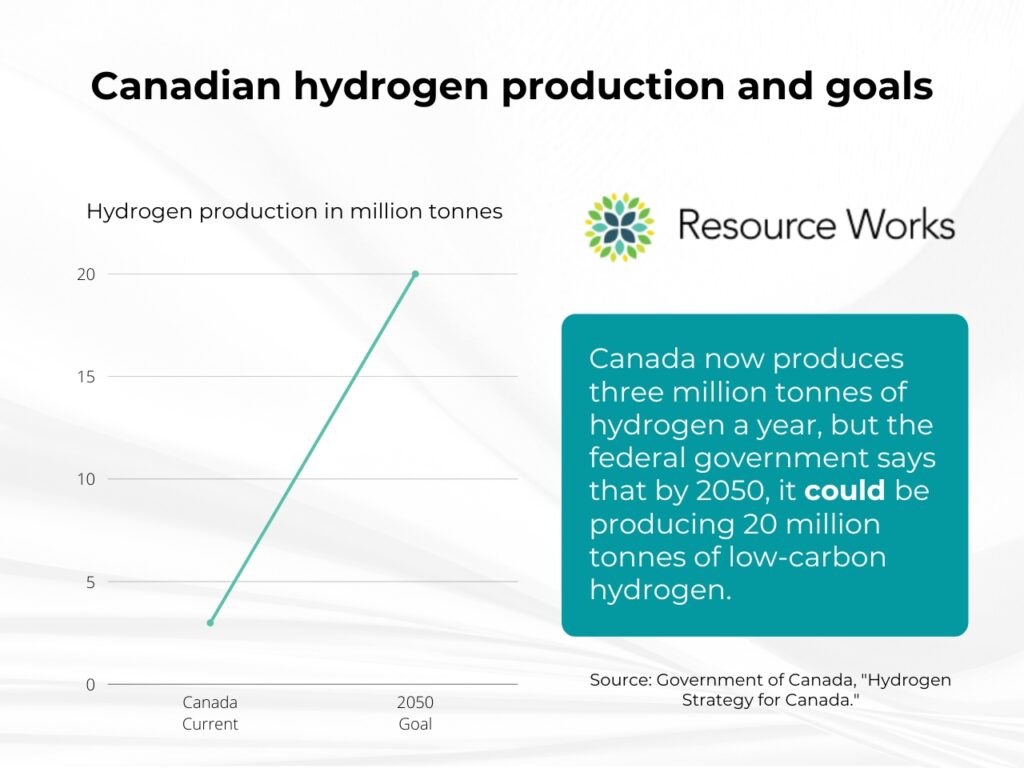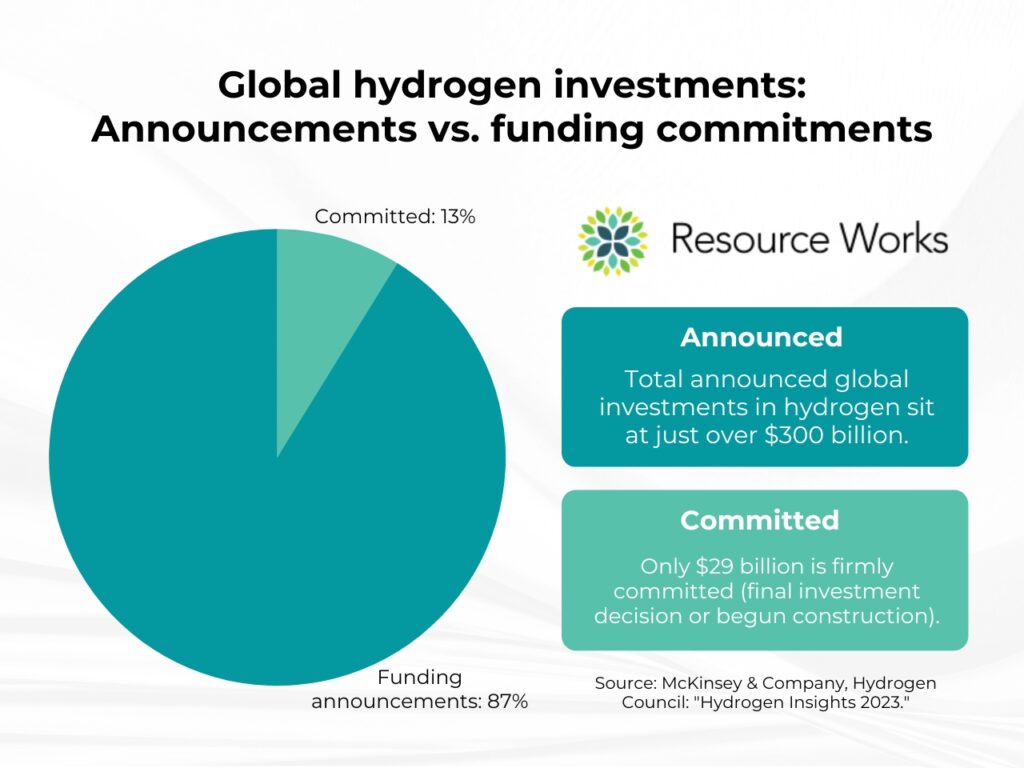In this reality check from Margareta Dovgal, find out why the hydrogen economy is the next big thing (but not yet).

Prime Minister Trudeau and German Chancellor Olaf Scholz at a hydrogen economy event. Photo by Adam Scotti (PMO).
More News and Views From Resource Works Here
Hydrogen: the clean and green fuel of the future, right?
It’s a narrative enthusiastically advanced by governments in advanced economies like Canada as they seek to reduce emissions.
Many such governments are offering generous subsidies to encourage hydrogen development and infrastructure. And who wants to challenge a transition to a fuel that, when burned for energy, emits nothing but water – a clean fuel that’s offered for cars and trucks, buses and trains, ships and planes and assorted industrial uses?
And yet hydrogen, despite presenting a growing opportunity for Canadian energy producers and the broader economy itself, is not without challenges.
A growing sector
Last autumn, the federal government proudly announced a hydrogen alliance with Germany, declaring the fuel essential to domestic and international emissions reductions progress and a transition to a global low carbon economy.
With hydrogen playing a part in federal and provincial decarbonization mandates, a lot of funding is opening up in an attempt to give the hydrogen industry the push industry insiders hope will kickstart wider adoption of the technology.
At the University of British Columbia, for example, a new hydrogen filling station opened for vehicles. There are a few others in BC (one just opened in Kelowna) and across Canada, and many more are planned.
It’s good to see BC positioning itself as a leader in the emerging hydrogen economy. And yet, with only slightly more than 1,000 refuelling stations in operation globally, it shows how far the fuel has to go to be seen by both vehicle manufacturers and drivers as a viable alternative to either standard combustion, gas fueled vehicles or electric vehicles (EVs).
But hydrogen has other uses in addition to replacing gasoline on the road. Those uses may combine to present a growing opportunity in Canada, from BC to Ontario.
In fact, Prince George has been recognized by some as an ideal area to develop a hydrogen hub. There, the McLeod Lake Indian Band is working with Mitsubishi Power toward a deal to build a hydrogen plant worth $5-7 billion, 90 kilometres north of Prince George.
Alberta is also betting on a growing hydrogen economy with a planned hydrogen hub in Edmonton that would include more than 25 projects related to production, transportation and end use of hydrogen, and carbon capture and storage. The Alberta government, no opponent to oil and gas, is nonetheless putting up $45 million to fund hydrogen innovation.
The private sector, too, is expressing an interest in investing in hydrogen. Pembina Pipelines signed an agreement with Japan’s Marubeni Corporation to develop a low-carbon hydrogen and ammonia facility in Alberta for exports to Asia.

Canada now produces some three million tonnes of hydrogen a year, and a report from the World Hydrogen Council speaks of 1,040 hydrogen projects globally. Approximately half of those projects are focused on large-scale industrial applications.
The federal government says that by 2050, Canada could be producing 20 million tonnes of low-carbon hydrogen — and “with potential for significant expansion to meet global demand,” while the latest energy outlook from the Canada Energy Regulator sees hydrogen use in Canada growing “modestly” to 2035 but accelerating thereafter.
Bloomberg New Energy Finance sees world hydrogen production rising to 500 million metric tonnes annually in 2050, a fivefold increase from today’s levels. Whatever the type of hydrogen energy, or the amount Canada produces, demand is growing.
Energy is energy
From government investment to private development, the growing hype around hydrogen reveals a basic truth: energy companies, and governments that rely on their economic contributions, have a fundamental interest in energy per se, not any specific form of energy.
It’s an often underappreciated fact that the oil and gas sector in Canada is also the largest investor and proponent of low to zero carbon energy, like hydrogen.
Canada needs all kinds of energy, and this is true for the rest of the world as well. The more green, affordable and reliable it is, the better. That’s why companies transporting Canadian natural gas to fuel LNG facilities on BC’s coast are also investing in hydrogen production.
On one hand, Asia needs a competitive alternative to coal, which BC natural gas and LNG can provide. And, on the other hand, if hydrogen can play a role in supporting a low-carbon economy closer to home, than that’s a win for everyone as well.
The key to a successful energy transition is to pursue both at the same time.
No silver bullet
Despite the growing interest in hydrogen around the world and the understandable enthusiasm of governments and environmental groups, the hydrogen story needs to be tempered with some hard truths.
One report sees the world hydrogen market as a $500-billion opportunity, and the hydrogen-generation market having a value of $263.5 billion by 2027.
But a Financial Times examination found that a net-zero economy and with Bloomberg’s reported 500 million tonnes of hydrogen by 2050 would require a staggering $20 trillion worth of investment.
To date, total announced global investments in hydrogen sit at just over $300 billion. And of that, only $29 billion is firmly committed (i.e., companies that have made a final investment decision or begun construction).

That’s not nothing. But it’s not what you’d expect for the next big thing.
Hundreds of hydrogen projects calling for billions of dollars have been floated by European governments, for example, yet only 7% of those have the financing to start construction, according to the latest data compiled by Bloomberg. And 82% of announced hydrogen projects lack offtake agreements.
“The hydrogen sector is now getting a lot of hype,” said Adithya Bhashyam, a hydrogen analyst at Bloomberg. “There’s a lot of project activity in terms of announcements and very little is actually being built.”
According to energy companies, one reason is that there’s not nearly enough infrastructure in place to use hydrogen as a fuel for power plants or transport it to end users, making it complicated to plan large-scale investments.
Even the hundreds of projects that have been proposed only have the capacity to provide about 3.5% of the European Union’s projected energy needs by 2030.
Thus Forbes Magazine asks: “So is hydrogen being oversold? Even though hydrogen fuel creates more excitement than solar or wind, 7% of the clean energy total forecast for hydrogen in 2050 is a pretty small percentage of the total. Add to this the excessive costs predicted to bring hydrogen online makes it tempting to admit that hydrogen is being oversold as a silver-bullet clean fuel for 2050.”
And Forbes adds: “A hydrogen industry may take a large bite out of the 5-7% hard-to-abate emissions of the world’s energy by 2050, but the biggest chunk of total emissions still remains: 93-95%.”
Infrastructure in a country the size of Canada will inevitably be a challenge. How, for one thing, do you move the hydrogen from where it is made to where it is to be used?
And where is all the money going to come from to build all these hydrogen facilities?
In Canada, the federal government is offering a tax credit for producers of low-carbon hydrogen. Ottawa says this credit could generate $21-billion worth of hydrogen development.
But a senate committee report says the low-carbon hydrogen sector is unlikely to develop on its own without further government support. “Or at least it will not develop at the pace required by NZE2050 (net zero greenhouse gas emissions by 2050).”
To make matters worse, the committee adds: “The domestic hydrogen sector is also at risk of investments going to other countries, such as the United States with its Inflation Reduction Act of 2022, that offer more generous incentives than Canada provides.”
Further complicating the picture is that many firms considered as potential users of green hydrogen currently use very little or none of it, and will need several years and hefty budgets to retool power systems to run effectively off hydrogen.
As Reuters columnist Gavin Maguire concludes: “The price of hydrogen versus alternative fuels, as well as the ability to supply the hydrogen economically to where it is needed, remain major hurdles that the industry will need to clear if the fuel is to fulfil its promise as the clean-burning solution to many of today’s dirty energy problems.”
As a final point, there’s also a concern that the role of hydrogen in decarbonization is being “very greatly overstated,” says Mark Winfield, professor of environmental and urban change at York University. This because much hydrogen now comes from fossil-fuel sources.
The International Energy Agency’s 2022 Global Hydrogen Review indicates that in 2021, global hydrogen production emitted 900 million tonnes of carbon dioxide — roughly 180 million more than the aviation industry.
In other words, whether on climate or economics, hydrogen is no silver bullet solution – yet.
Conclusion: A balanced path forward

Prime Minister Trudeau and German Chancellor Olaf Scholz at a hydrogen economy event. Photo by Adam Scotti (PMO).
Hydrogen stands at the forefront of the global pursuit of clean and renewable energy, brimming with potential and the promise of a low-carbon future. Yet, as Canada’s burgeoning hydrogen industry reveals, this is a road filled with both excitement and caution.
The investments and alliances forged by governments, the strides taken by private companies and the enthusiasm surrounding new projects are undeniable signs of progress.
And yet, hydrogen is not a silver bullet. The challenges of infrastructure, production and financing are serious hurdles that must be acknowledged and addressed. The disparity between ambitious announcements and actual construction, the comparison with more mature technologies like LNG and the complex economics of scaling up all serve as reminders that hydrogen’s journey is still in its early stages.
By all means, governments should do what they can to encourage the improvement of the sector and remove regulatory and infrastructure problems where they exist. But governments also need to be honest with their citizens: this sector is not yet a cash cow, and it’s certainly not a replacement for conventional fuels. It could be decades before the sector develops to a level accessible for general use, and it needs to be hydrogen entrepreneurs, scientists and engineers who lead the way. Government investments (or bailouts) are bandaid solutions, not the foundation of a viable energy economy.
The path forward must be one of balance and collaboration. By recognizing hydrogen’s potential without neglecting other essential energy solutions, Canada can lead in shaping an energy landscape that is green, affordable and reliable. It can prosper today while investing in tomorrow.
Until then, as the kids say, “don’t believe the hype.”
Margareta Dovgal is the Managing Director at Resource Works. Follow her on Twitter and LinkedIn for more hot takes on natural resources and making the world a better, more secure and prosperous place.
Share This:



